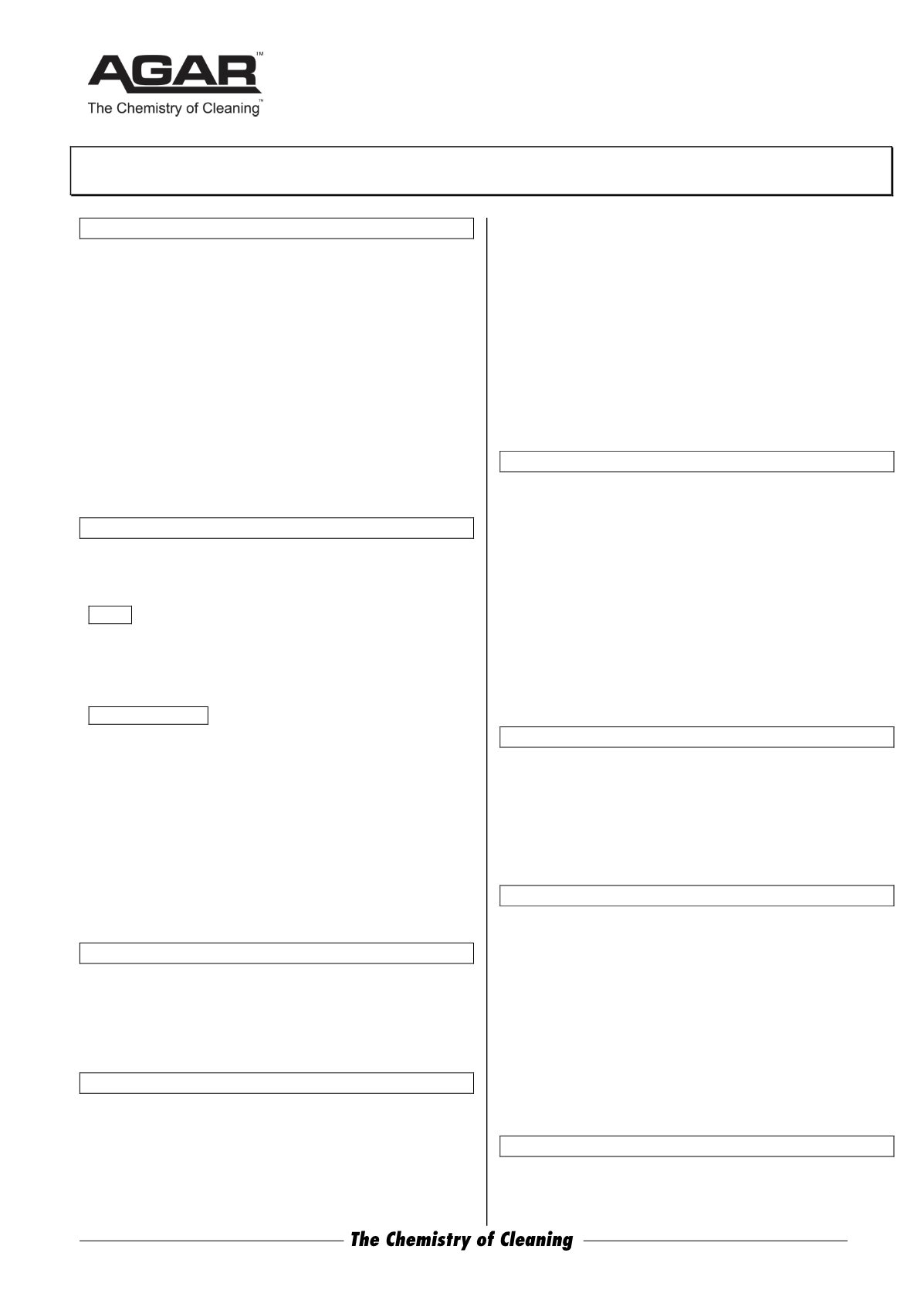

ABN 80 004 726 890 | MADE IN AUSTRALIA
VIC 03 9480 3000
NSW 02 9743 6020
SA 08 8293 2020
QLD 07 3274 3438
WA 08 9249 4566
Safety Data Sheet
Issued: December 18, 2015
Page 1 of 3
DLX CITRUS DEGREASER
1 IDENTIFICATION OF THE MATERIAL AND SUPPLIER
Product Name:
DLX CITRUS DEGREASER
Other Names: Flammable Liquid, N.O.S
Manufacturer's Product Code: DL1, DL5
Product Use: Solvent-based cleaner for removing grease, oil,
tar, ink, adhesive and chewing gum stains.
COMPANY DETAILS
Company: Agar Cleaning Systems Pty. Ltd.
Address: 12-14 Cope Street, Preston, Vic. 3072
Telephone: 03 9480 3000 Facsimile: 03 9480 5100
Web:
www.agar.com.auAgar SDS are available from this website.
E-mail:
admin@agar.com.auEmergency Telephone Number: 131 126
(Aust wide)
2 HAZARDS IDENTIFICATION
Hazardous according to criteria of Safe Work Australia.
Irritant Xi. Classed as Dangerous Goods.
Risks: Flammable. [R10]
Irritating to eyes and skin. [R36/38]
May cause sensitisation by skin contact. [R43]
Safety Directions:
Keep out of the reach of children. [S2]
Avoid contact with skin. [S24]
Wear suitable gloves. [S37]
This material and its container must be disposed
of as hazardous waste. [S60]
Avoid release to the environment. Refer to special
instructions/Material Safety Data Sheets. [S61]
3 COMPOSITION / INFORMATION ON INGREDIENTS
Ingredients:
Chemical Entity:
CAS No.:
Proportion:
d-Limonene/dipentene 5989-27-5 > 60%
Ethanol 64-17-5 < 10%
Surfactants and other non-hazardous ingredients 10 - < 30%
4 FIRST AID MEASURES
Poisons Information Centre: Phone 131 126
Swallowed
: If poisoning occurs, contact a doctor or Poisons
Information Centre. If swallowed, do NOT induce vomiting due
to the hazard of solvent aspiration into the lungs. Rinse mouth
with water. Never give anything by mouth to an unconscious
person.
Eye:
Immediately hold the eyes open and wash continuously for
at least 10 minutes with fresh running water. Ensure irrigation
under eyelids by occasionally lifting the upper and lower lids.
Seek medical advice. Removal of contact lenses after an eye
injury should only be undertaken by skilled personnel.
Skin:
Remove any contaminated clothing and flush area with
water. Wash the skin thoroughly with soap and water. Seek
medical attention in the event of irritation.
Inhaled:
Remove from the source of vapour, spray or fumes.
Remove patient to open space or fresh air, rest patient, keep
warm and seek medical advice. Give artificial respiration if
breathing stops. Provide oxygen if required.
Advice to Doctor: After vomiting, give water, milk or milk of
magnesia to drink.
5 FIRE FIGHTING MEASURES
Fire/Explosion Hazard: DLX is flammable.
Extinguishing media: Water fog, fine water spray, foam or dry
agent. Carbon dioxide and sand. Do not use water jets.
Special Fire Fighting Procedures: Firefighters should use self
contained breathing apparatus and protective gloves in case
of fire. In case of fire, the material can be violently or even
explosively reactive; wear appropriate protection gear. In case
of fire, prevent by any means possible spillage from entering
drains or water courses. Use water spray to cool containers.
Fire fighting PPE: SCBA and structural fire fighter’s uniform may
provide limited protection. Fully encapsulating, gas-tight suits
should be worn for maximum protection.
Fire/Explosion/Decomposition Hazards: No unusual fire or
explosion hazards. When heated to decomposition, acrid
smoke and fumes as well as CO and CO
2
are emitted.
6 ACCIDENTAL RELEASE MEASURES
Shut off all possible sources of ignition. Ventilate the spillage
area thoroughly. Personnel involved in clean-up require
adequate skin, eye and respiratory protection. Pump the liquid
away and soak up the rest with an absorbent, non-flammable
material. Wash the contaminated area with water and
detergent. Prevent entry into waterways, drains or confined
areas.
7 HANDLING AND STORAGE
Storage and Transport: Keep the container tightly closed. Take
precautionary measures against static discharges. Store in a
cool, well-ventilated , low-fire risk area, away from sources of
heat or ignition. Keep away from strong oxidising agents. Keep
out of reach of children.
Reactivity Hazards: Thermal oxidative degradation products
include carbon monoxide (CO) and carbon dioxide (CO2)
Incompatibility (Materials to avoid for purposes of transport,
handling and storage only): Avoid all ignition sources. Vapour
may form explosive mixtures with air. Class 3 Flammable
Liquids shall not be loaded in the same vehicle with: Class 1,
2.1, 2.3, 4.2, 5.1, 5.2 or 7 substances.
8 EXPOSURE CONTROLS / PERSONAL PROTECTION
Exposure Standards: Threshold limit value 100 ppm (estimated)
Engineering Controls: Use only in well ventilated areas. Local
Please turn to page 2.


















